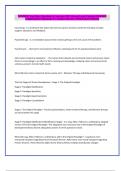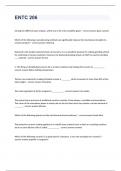NCMHCE Test Prep | Questions & Answers (100 %Score) Latest Updated 2024/2025
Comprehensive Questions A+ Graded Answers | With Expert Solutions
Counseling - Is a treatment that allows the client to express emotions while the therapist provides
support, education, and feedback.
Psychotherapy - Is a remediation process that involves getting to the root cause of the problem.
Freud found... - that Kant's interactionism offered a starting point for his psychoanalytical work.
John Locke's empiricist viewpoint... - The human brain absorbs environmental events and sensory inputs
from its surroundings in an effort to form meaning and knowledge--studying nature and environment
unlocks a person's mental health needs.
What did John Locke's empiricist theory evolve into? - Behavior Therapy and Behavioral Counseling
The Five Stages of Theory Development - Stage 1: The Original Paradigm
Stage 2: Paradigm Modification
Stage 3: Paradigm Specificity
Stage 4: Paradigm Experimentation
Stage 5: Paradigm Consolidation
Stage 1: The Original Paradigm - Freud's psychoanalysis, client-centered therapy, and behavior therapy
are found within this stage
Stage 2: Paradigm Modification (Modification Stage) - It is Jung, Adler, Patterson, and Bandura adapted
version of Freud's Original Paradigm. This adaptation was necessary due to the Original Paradigm of
development theory did not adequately answer all of the questions raised.
What did Jung, Adler, Patterson, and Bandura add to the Original Paradigm? - Jung had a more
restrained viewpoint regarding Freud's bisexual theories. Adler had a more social viewpoint regarding
Freud's theories. These theorists added to the theory without making revolutionary changes.
,Stage 3: Paradigm Specificity (Specificity Stage) - Changes to counseling tactics were initiated by Berne,
Jourard, Genlin, Beck, and Krumboltz. Berne replaced Freud's superego, id, and ego with adapted terms
referring to parent, child, and adult. Berne's new terminology allowed for Freud's to remain intact but
with minor changes to the terminology.
Stage 4: Paradigm Experimentation (Experimentation Stage) - Strupp, Mitchell, Aron, Ellis, Beutler,
Wexler, and Lazarus initiated changes to the rules for conducting counseling sessions. These theorists
began making abstract structures, practices, and paradigm-linked procedures.
Stage 5: Paradigm Consolidation - This stage is in the process of being developed
Community Psychology - The incorporation of psychological values and theories into publicly accessed
areas within towns and neighborhoods
Mental Health Centers - Neighborhood and local community health services provided by psychiatrists,
psychologists, and social workers. These centers originated out of legislation signed by John F. Kennedy.
Individual Therapy - Private counseling and psychotherapy sessions with a single client and a therapist.
The initial session is designed to identity problems that require subsequent modification techniques.
Group Therapy - Provides counseling and psychotherapy to a patient through group interaction and
exchanges designed to help the individual to talk about personal issues in an atmosphere where the
individual can gain active help and encouragement from other members of the group.
Family Therapy - Provides counseling and psychotherapy to a patient and his/her/their family through
sessions with a therapist designed to help the patient identify problems in which the family can
intervene and help resolve or improve.
What are the three types of delivery systems? - Individual therapy, group therapy, and family therapy
Human Modalities - Refers to the three classifications of models known as the Cognition (C), Affect (A),
and Behavior (B).
,What is the Humanistic Behavior Model? - It is a 3 stage model developed by Robert Carkhuff in 1969
What are the stages of the model of Humanistic Behavior? - Stage 1: Facilitation: the relationship is
cultivated between the client and therapist
Stage 2: Self-awareness, which allows the patient to find out more about the reasons behind
his/her/their behavior through discussion with the therapist that expands on the issues surrounding the
understanding of self
Stage 3: Relates to the actions or measures that are to be taken
Humanistic Behavior combines what? - This model incorporates client-centered therapy and behavior
therapy. Humanistic Behavior is an (A) or affective model.
What is the Personal Science model? - Personal Science was developed in 1977 by Michael Mahoney,
based off the cognitive-behavioral (CB) approach. Uses SCIENCE as it's steps.
What is SCIENCE? - S: Specification of the problem
C: Collection of data or facts
I: Identification of patterns or reasons for existing behaviors
E: Examination of choices that can be used to modify behavior
N: Narrowing the options and experimenting with possible modifications
C: Comparing data or facts
E: Expanding, modifying, or substituting unwanted behaviors for more preferred behaviors
What is Rational Behavior Therapy? - This model was developed in 1977 by Maxie c. Maultsby Jr. It is a
more direct method of dealing with a patient's emotional state than Ellis' Rational Emotive therapy from
the mid-1950's. Rational Behavior is based on the cognitive-behavioral approach and has 5 steps known
as emotional re-education.
What are the steps of Emotional Re-education? - Step 1: Self-analysis using rational thought helps the
patient to gain intellectual insights
Step 2: Changing actions or behaviors to reflect newly gained intellectual insights
, Step 3: Cognitive emotive dissonance is a refocus of attention that helps the patient bring feelings and
thought patterns into alignment with each other
Step 4: Rationalized feelings promote cohesive thought patterns through consistent emotional insights
Stage 5: Habitual practice of newly gained insights develops new personality traits
Who developed psychobehavioral therapy? - It was developed in 1971 by George Woody
Psychobehavioral therapy is a combination of? - It is a combination of psychoanalytic and behavioral
techniques. It is based on the cognitive behavioral approach.
What is Multimodal Behavior Therapy? - It was invented in 1971 by Arnold Lazarus. It is a complex
system that combines client-conceptualization into all the human modalities of cognition, affect, and
behavior that cannot be excluded from a client's everyday life. He used the BASIC ID acronym for the 7
modalities.
What is the acronym BASIC ID? - B: Behavior
A: Affect
S: Sensory
I: Imagery
C: Cognition
I: Intrapersonal
D: Drugs
How is Multimodal Behavior Therapy used? - There is no guide for which technique to utilize for
treatment. There is no set therapy process or steps to take. It identifies a theme and then the therapist
uses BASIC ID techniques for client treatment.
What is brief crisis intervention therapy? - This is used to help clients come to terms with a life event or
societal change such as a natural disaster, sexual assault, violence in the workplace, criminal
victimization, suicidal/homicidal ideations (telephone lines such as 988), catastrophic illness/injury,
drastic relationship changes





